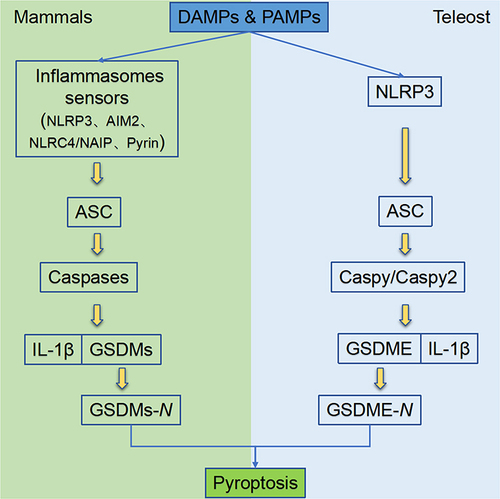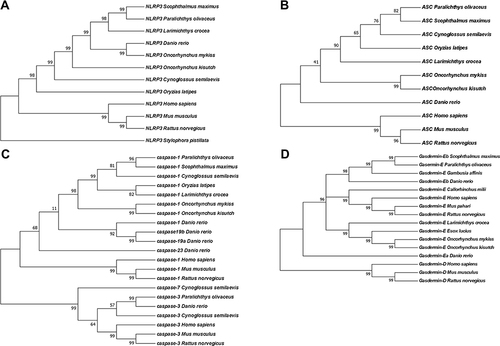Figures & data

Figure 1 The pyroptosis pathway in mammals (A) and teleost (B). (A) Pyroptosis in mammals can generally be divided into four pathways.Citation21,Citation32,Citation36 In the classical pathway, PAMPs and DAMPs can be recognized by the PRRs in the cell membrane to induce NLRP3 which further activate ASC and pro-caspase-1 through PYD-PYD and CARD-CARD interaction. Activated caspase-1 can cleave GSDMD to release its NT-domain which can oligomerize to induce perforation in the cell membrane and also activate IL-1β and IL-18 which can release via the cell pore. In the non-classical pathway, caspase-4/5 (human) and −11 (mouse) can be activated after directly binding to cytoplasmic LPS. The activated caspase-4/5 and −11 can cleave GSDMD to release its NT-domain and form the micropores in cell membrane. Caspase-4/5 do not have the same ability to activate IL-1β and IL-18 as caspase-1, but caspase-11 can promote the mature of pro-IL-1β and IL-18 by NLRP3. In the caspase-3/8-mediated pathway, caspase-8 can be activated by TNF-α and other apoptotic signals to activate caspase-3, which can cleave GSDMD to release its NT-domain to form pores in cell membrane and induce pyroptosis. In the Granzyme-mediated pathway, GzmA derived from lymphocytes can cleave the Lys229/Lys244 site of GSDMB to induce cell perforation, meanwhile, GzmB released by CAR T cells can activate the caspase-3/GSDME pathway to induce pyroptosis.(B) Pyroptosis in teleost are executed by GSDME and can be divided into two ways according to the ASC-dependence or not.Citation15,Citation37 In the ASC-dependent pathway, the activated NLRP3 inflammasome by DAMPs or PAMPs can recruit ASC through the PYD-PYD interaction, which can further recruit caspy and then caspy2 through the CARD-CARD interaction. The activated caspy/caspy2 is responsible for the cleavage of GSDMEa/b and the mature of IL-1β. In the ASC-independent pathway, the activated NLRP3 can directly bind with caspy2 through PYD-PYD interaction, and the activated caspy2 can cleave GSDMEa/b to release its NT-domain and form pores in the cell membrane.

Figure 2 Phylogenetic trees of genes involved in pyroptosis including GSDMD and GSDME (A), caspases (B), NLRP3 (C), ASC (D) in representative teleost and mammals.

